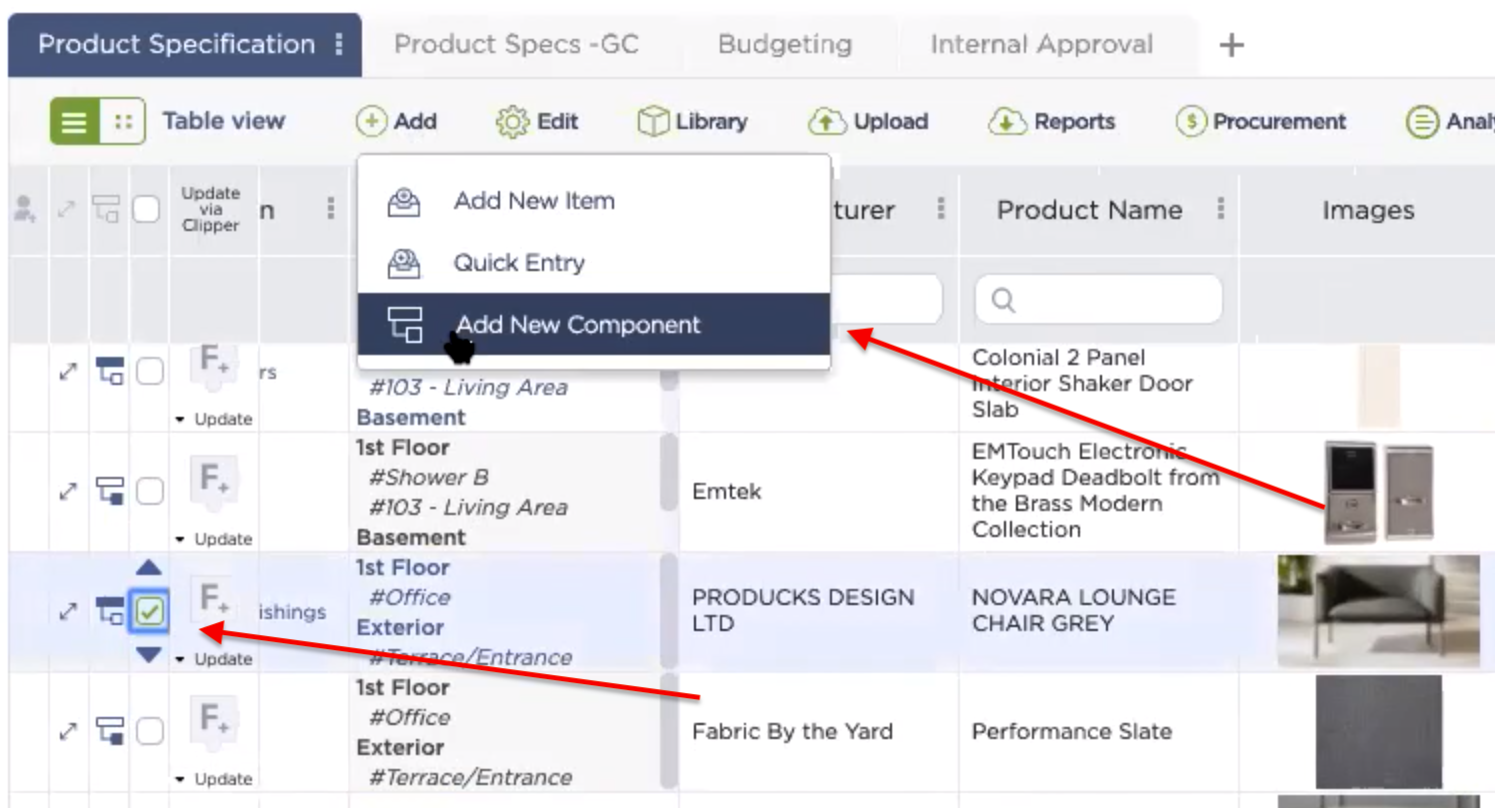
Restrictions are slowly being lifted and design projects are gradually being picked back up around the world. Here are 5 areas you can collaborate better, remove friction, and increase efficiency in your design workflow.
Manage your FF&E and finish items’ quantities (and other data) faster.
Instead of having to manually scroll through your list of rooms — which can be a very long list, especially if you’re working on a commercial project — you can now search for a specific room simply by typing its name in.
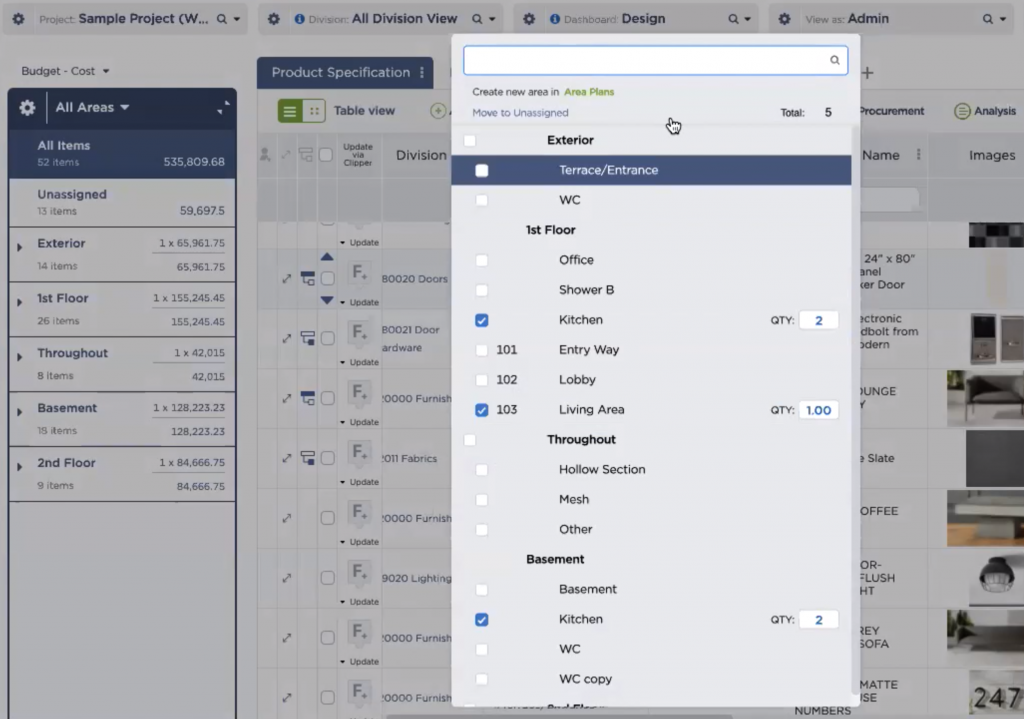
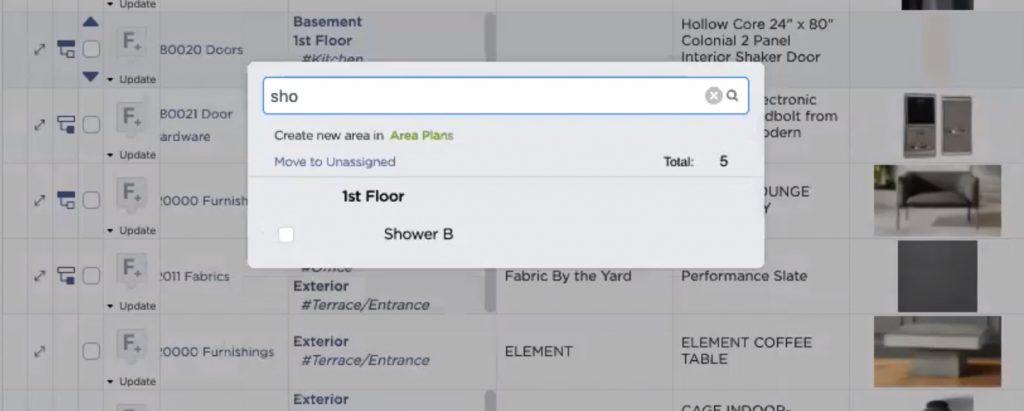
You can also input other types of data faster (ie without having to scroll left and right) simply by switching to table view or opening an item as a whole page.
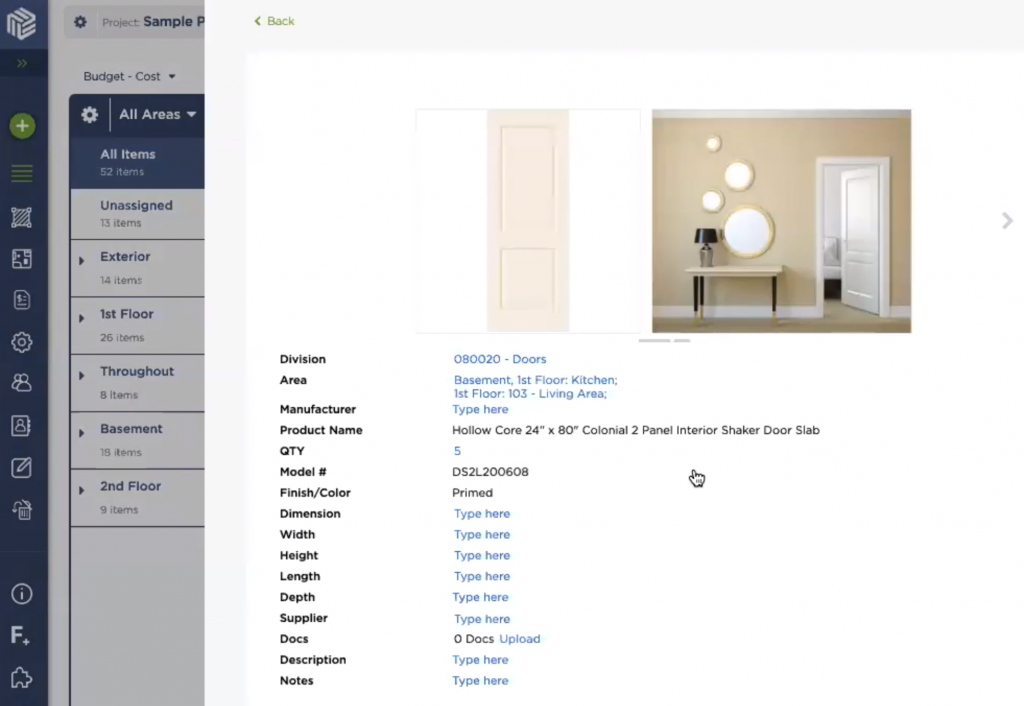
Turn your mood boards/concept boards into complete spec sheets.
For many interior designers, a project starts in a very visual manner — that is, putting together a mood board before creating a spec book.
But wouldn’t it be nice if you didn’t have to add your mood board items into a spec sheet manually? What if you could click a button, and all those product images could be transformed into a spec book?
Well, now you can. Simply click the “Export items to dashboard” button and all items in your mood board will be pushed to your dashboard.
Bonus: You can automatically add annotations to your images, too.

Manage components for your custom furniture.
Custom pieces are prone to adding that layer of complexity that specification and procurement so desperately need. (Kidding — spec sheets are more than complicated enough, as you well know.)
With our new Components feature, you can now treat each component as a separate item but link them together to show where each of them belong.
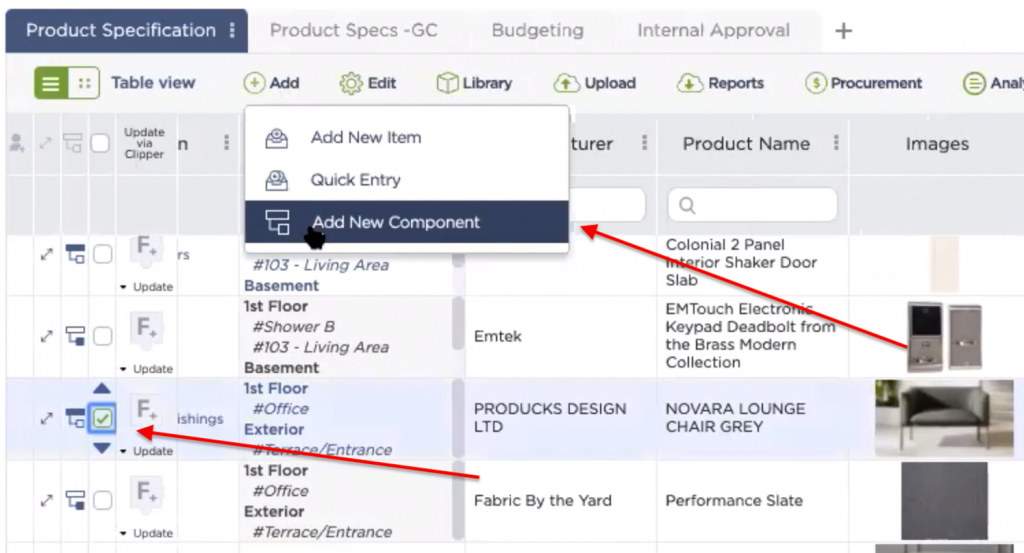
Additionally, you can also create a concept board for your custom furniture within your mood board, then pull it to your dashboard as an image that you can send to your manufacturer.
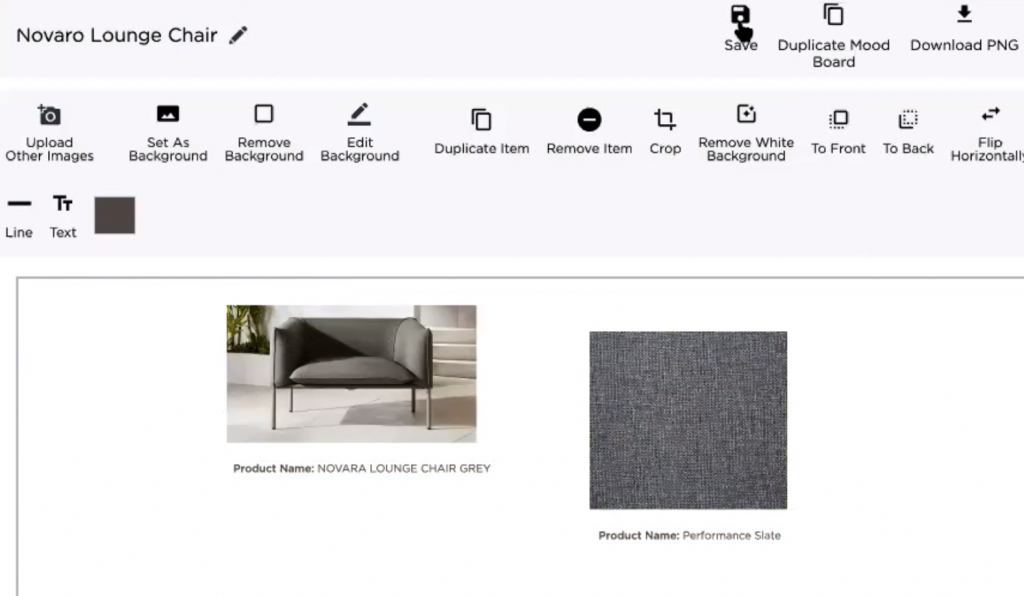
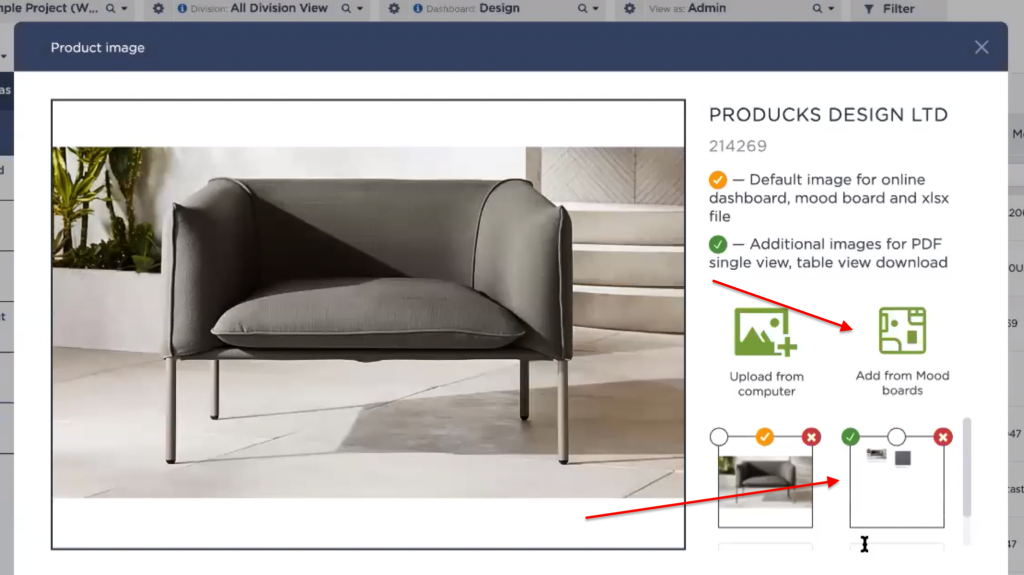
Collaborate on design projects more easily and securely — with anyone.
Share a project with a client. Invite your subcontractors to view your lighting schedule. Give suppliers access to specific products so they can upload their bids and other information.
Fohlio’s new functionality for sharing with external collaborators is now so much more flexible, giving you granular control over who sees what.
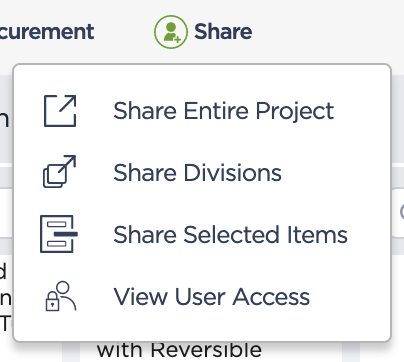
Analyze project costs according to how PO status.
You’ve always been able to quickly see how much the items in a specific area or product division cost. Now, you can dig even deeper into your financials with the ability to see how much you’ve paid out so far, how much is still due to suppliers, and more.
The new cost analysis feature also allows you to compare the total cost of what you’ve specified versus what you’ve already purchased, and see if you’re spending too much in one area or have some budget left over to add new things or upgrade to more expensive pieces.
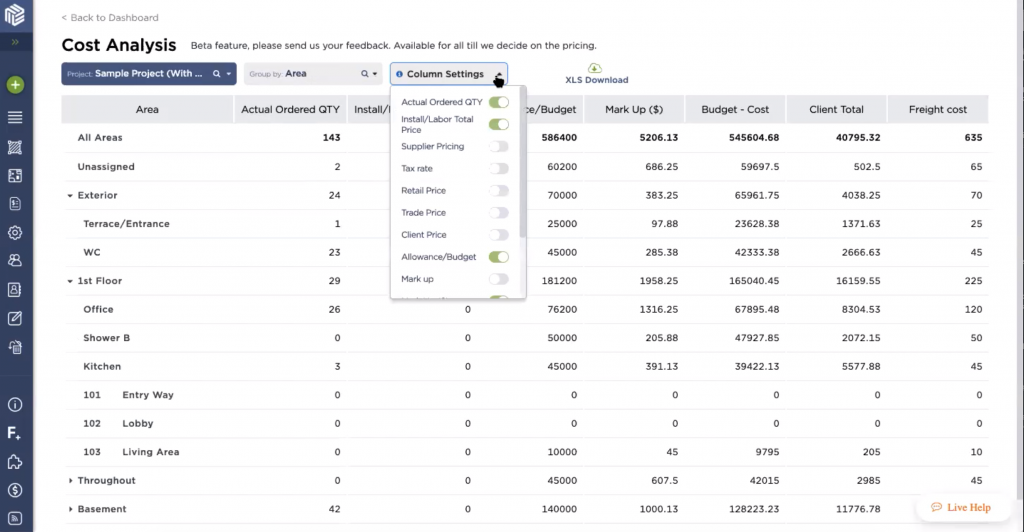
Fohlio helps you specify, procure, manage data, and more on one platform: Collaborations are easy and workflows are much more efficient than ever before! Get your free trial today — so you can design and build more profitable projects.
Want to learn more about how to specify and procure FF&E, finishes, and other materials faster? Watch this webinar:
Transcript:
Hi. Hey, let’s get started. Okay. So hello everyone. Good afternoon. And welcome to today’s folio webinar. I hope you all had a good Memorial day weekend. And for those of you who are joining us from outside of the U S I hope you’ve been having a good week so far. I’m your host Ingrid Velasquez Woodley. I’m also the head of content and marketing for folio. And with me today is we’ve been you, who is the head of our design and development team. Hello, Huibin.
Hi, how are you?
Good, good. Thank you. Uh, so today we would like to introduce you to the features that we’ve released in the past couple of months. And more importantly, we want to show you how you can use these new functionality so that you can take advantage of faster specification in procurement as the economy reopens. So today we are going to talk about a faster way to assign quantities to your items, how to turn your mood boards into spec sheets for that duplicating work, linking components to create custom furniture, how to analyze your cost costs, according to supplier and PO status secure and flexible sharing with external collaborators and a lot,
lot more.
Okay.
Yep. And after that, we didn’t talk about some of the new features now pipeline, and then we’re going to open up for Q and a.
Yup. Um, alright. So yeah, we do have a lot of things to talk about today. So we’ve been, uh, can you please start with how folio has made it easier to input data for users who have a lot of columns?
Uh, so let’s use your screen. Yep. I’m gonna make sure that I have more control.
Okay. So, um, first of all, um, after we roll out the, um, dashboard with different templates options, um, some of our users, um, really took advantage of that and create a different phase templates to, uh, manage, uh, their processes and workflow. Um, however, um, some of them face their problem that they have lots of columns and is not particularly user friendly for them to have to scroll left. And right. So we did two improvement. One is to rod this at grid view so that you can see all that the relevant columns are a face specific product categories. In one single screen. You can also leverage this open asset page. So what the table view, you can see many part information at once. If you want to zoom in, into one particular pod information, just click on this expand button and open that part as a single page and start doing import right here.
Yeah.
Another, um, uh, actually I cannot switch screen. Give me a second.
[inaudible]
another improvement we have rolled out is to, um, uh, make assigning quantity to a certain area easier. So, uh, especially for the folks who are working on larger projects, like commercial projects, you might have lots of rooms. Um, so, uh, instead of having to, you know, um, eyeball and try to room, trying to find a room number you’re looking for now, we actually redid this, uh, area column. So that if you’re one to assign, for example, does particular item to your shower area, and you can just type in a certain key, well, we’ll have auto suggest, uh, for you to select, um, and that area and assigned a quantity. Okay. So, um, this would make us signing quantity to different areas, much faster. So, um, Ingrid, um, now we are talking about, um, like improvements and made things easier. Maybe you can tell us a little bit about and we’re board and how it can improve the efficiencies.
Yep, absolutely. So essentially, and I think you’ll find this really cool. What we’ve, um, what we’ve done is that we need a lot, uh, the mood board a lot more functional by integrating it a lot more closely with the dashboard. And you’ll see what I mean here in a second. So in the past, the mood board function was a great tool for quickly putting together a concept board by dragging and dropping images. But now in addition to that, you can automatically add annotations or notes to the bottom of your images, and you can select which data is going to be pulled right here. And you can actually select as many bits of data as you want.
And then the other thing is that, um, because a lot of you have been telling us about how your process is very visual in the beginning. And so the first thing you do is put together a mood board and then create the spec sheet, but then, you know, it would be nice to not have to double that effort in that you’re going to have to create a, um, a separate spec sheet for that. Well, now you don’t have to, because everything you add to your mood board, you can now push to your dashboard using this button. So let’s go ahead and do that. Let’s just save this. So once you’ve clicked there, it’s going to ask you to choose where these items are going to go, just click confirm, and it’ll take you straight back to your dashboard. And then the other thing, lastly, about the mood board, is that something that is going to be pretty useful for when you’re creating custom pieces? Is this, Oh, let’s see. I’m putting together that lounge chair, for example. Okay. So this, so if you’re putting together custom pieces, um, let’s say this chair and you want to use this particular piece of fabric for it.
So now you have this comp uh, this concept bore that you can share with your clients or your, um, your custom manufacturer. And what you can do is before you send the spec sheet over it to them, you can actually add that, um, concept to board, to your spec sheet, just by going to the images clicking there and then pulling it from your dashboard. So now you’re able to enhance the amount of, um, you know, detail and data that you are, um, that you’re putting together for, for either your client or your manufacturer. Um, but speaking of custom furniture, um, we’ve been, can you tell us please about how users can now link together separate components for custom pieces?
Absolutely. So we have, we’re all a component feature. We haven’t tried it out. I really recommend to give it a shot. So, uh, essentially, um, what we heard from our user is that one day do custom pieces, or maybe just like, you know, I have to figure out how much like, which, how, where they have Dubai for a certain, um, like, you know, cabin cheese or door. Um, they need to really do it like, like, you know, different combinations, so, and purchase those items separately to components as separate from the parent item. Therefore we RA a component feature as you can see this little icon here. Okay. And, and this particular customer,
okay.
Sofa, we attach the fabric
as a component
to this, and also,
um, define that there are 10 yards of each fabric and for this, uh, tenure of the fabric of each chair, and it will automatically calculate how many yards of fabric we have to buy. Depends on the quantity of the parent item. You can do the same, for example, here, here’s a adored hardware for the door. And, um, and after you, uh, create those like components, they can be used in your library as well. So if I want to add a component to a parent item, I can do add, add new components and start from scratch, or I can go to a library and then Slack a certain, for example, fabric item for my fabric library and attach as a component. And once you’re ready to do procurements, when you need to issue to purchase order, um, you can definitely, uh, for example, Fuder owl your, um, item as a component only, and then create purchase order, uh, for the components separately. And then you can also, uh, like no to issue a purchase order for the parents separately, if you need to [inaudible].
Um, and then, uh, speaking about components and also how you can eat your purchase orders, uh, for different components. We did roll out some enhancements for the appeal were floated as well. So let me, um, show you guys how it works.
So, um, this is our purchase order, um, table. And then for example, if I have this purchase order in draft status, um, and sometimes you might actually have, um, different items need to ship to different places, or, um, that item is directly billed to the client by not be owed, um, not a beauty to yourself. Um, therefore we give you more flexibility in terms of like, you know, what, um, shipped to Agis as well as more beautiful address you can add. So, uh, for different projects, you can set up a certain address as the Ford project shipped to address. You can also add a new address for different items that might go to a, like a warehouse or the job site, et cetera. And then you can also add different, like, for example, a beautiful address as you see fee there for, uh, for different projects. Um, so, uh, we’re going to continue to continue to do some enhancements on the PO, so please stay tuned. And then, um, another in husband does really closely related to, um, the whole purchasing as well as managing the budget and costs is the cost analysis feature. We just rolled out actually yesterday.
So it’s currently in production. Beta is available for all the users to give it a try. So, um, please feel free to poke around and let us know what you think. So essentially now, um, there is analysis button. Once you click into it, you can look at the cost, um, that’s, uh, by area as well as light by divisions. And, um, if you already use procurement functions to manage the whole purchasing with your suppliers, you can also see the breakdown of how much you’re spending and given PO status by suppliers. Um, if you, um, grew by PO status, um, you know, as we give a view in terms of like, you know, how much I already pay and how much is PO and how much do to the suppliers, uh, again, there’s a lot of flexibility. Um, there are different columns and you can choose to make it available for you in this table.
And then if you need to download a table into Excel format for further analysis and your a separate software or, um, outer systems, you can definitely download a Xcel asset file from here. And then related to this whole cost analysis. We also has, um, been working on a budgeting feature. So now, if you are creating a new project, there is a fuel for you to input the, uh, budget for their whole project. And, uh, if you, um, you know, for existing project, you can go here in the project editor and add some budget here. So how it will work is that the total project budget information was show up on top of your
[inaudible]
area plan. So as you star specifying things, um, if you want to compare it, you know, how much is the actual specify or, uh, even like procure total pay total versus your budget. And this is the place to compare them and see what you’re spending too much, or there’s a lot of room for you to add some new things or buy more expensive stuff. So, um, now, uh, maybe like Ingrid, since we talk about the, um, procurements, and we also have raw as some improvements in terms of collaborating with like, you know, suppliers or even clients and give them, uh, give our users more flexibility, as well as control how to share information with them. Um, can you tell us something about the advanced, the sharing function?
Yup, absolutely. Um, so as is normal with a lot of projects, um, you’re going to be working with people who are not necessarily, um, a part of your team, but you are collaborating with anyway. And so we call them external collaborators. It could be like a client or a consultant, or, um, you know, as most of you guys are designed firms, you’re going to be working with, let’s say contractors slash builders. Um, we’ve put together a lot of, um, functionalities that give you more flexibility and allow you more granularity in what you’re sharing with, um, with your external collaborators. So here you can see that you have three options for sharing. Uh, you can share an entire project or just divisions or just some selected items. So let me go through this one by one. So let’s say that you are sharing the entire project with your client because you’ve picked out products and you want to get their approval for, um, their final approval for the product so that you can start the procurement process.
So what you do is you type in their email, select their role, and you see that we’ve, um, you’ve already put together, um, some preset roles so that you don’t have to do it yourself, which, um, select which phases you’re going to share. So in this case, it’ll be owner approval. And what kind of view would you like them to see? So right now we’re looking at table view, but as you saw earlier, we also have grid views. So you can choose to show that to them as well. Depends on what you and your client are comfortable with. And then you can also, um, give them the option to add new items. If you like then, um, add a, just use the default message or add your own custom message. And then you just share that. And then, um, you would want to probably share divisions specific divisions of a project if you’re looking, uh, I mean, if you’re working with, let’s say a subcontractor, so let’s say for this week that you are, um, you’re installing flooring.
And so you want to share, um, the installation phase with them. Um, table view is probably good. So it’s mostly the same, um, all throughout, as you can see. And then here is where you can select which divisions you want to share. So just flooring for now, because that’s all we’re working on with this team, with this specific team of contractors. And lastly, you have the option of just sharing some select items. And this is especially useful for when you’re working with suppliers. So let’s say these three items, um, you are trying to bid them out. Um, so first thing you want to do is like the items you want to share and then click share your selected items. And this is going to go out to my potential suppliers, again, select all of these options that, um, that you’re comfortable with. Um, you can allow them to add new items if you want.
And the nice thing about this option is that if you are working with more than one supplier and they’re going to be bidding against each other, they can upload their, uh, their product data to directly to your project. And they won’t see each other’s information. And that way you’re still keeping that privacy between them so that you can have, um, you know, a good bidding process. Um, and then one last thing I wanted to show you about this is if you look at viewer access under external user list, you are going to see a list of all of the users that, um, or external users that you’ve invited to your projects, what their role is, um, when they last opened the project, or if they’ve not opened it yet, who invited them, which projects they’ve been invited to here, you can edit their access after the fact. And of course you can also remove them. Um, and then under roles and access is where you’ll see that list of rules that has been preset. And if you click on settings, you’ll see a list of all of your existing columns and what sort of access they have to each of those.
Alright, so that is it for external sharing, but speaking of working with different entities or clients, we have had a lot of requests for the ability to save multiple templates. Uh, we’ve been, can you please tell us more about this? Absolutely.
So, um, as you all know, some of your clients could be, you know, roughly relatively picky, especially if you’re servicing some corporate clients who has their own design guides and templates, dad, um, with a certain logo or font or format I have to follow. Um, it could be a difficult, um, situation for you, um, because you have all the data, your library set up in folio that you try to standarize, uh, uh, meanwhile you different clients of yours. My one YouTube create a very custom, uh, presentation format. And so it’s not really that efficient. If you have to copy and paste those data all over again into the format that day required, um, therefore weeks spend the custom presentation feature. Um, for example, you can actually
okay,
um, uh, request, uh, us to set up, uh, some standard formats that representative clients lay our requirements, and then you can select which template you want to choose and generate a template in, uh, actually Microsoft word document format. Uh, so that will give you more flexibility to further added those documents as you see fit. Um, so yes, if you have situation like that, you want to take advantage of, um, this kind of like no custom white glove services, but also make sure that your product, um, data is standardized and folio. It can virtualize and we can do assessments and then, uh, charge you interest at one time fee to set up those custom templates.
Okay.
Okay. Um, and, uh, so, so those are the new features that we have raw in the past, like North me four months. And then we get to talk about some of their, um, new features we have been working on. And meanwhile, uh, we do have a Q and a button actually. Um, if you have some questions is, um, you can feel free to start typing in your questions for the way you can start answering your questions after we go over to new features coming out. Um, and so, um, Ingrid, do you mind show their, um, presentation page with a new feature listing? Yep, absolutely.
[inaudible].
There we go. Yup. Thank you. So, uh, one of the big theme we have been, um, you know, putting a lot of focus on it’s really improve the usability of the dashboard. So our dashboards are getting, you know, just a lot more functions adding to it. Um, we don’t want it to be too overwhelming, um, as we continue to, uh, more richness of the features. So we have been really putting some strategy in terms of how to simplify their dashboard UI. I mean, while give you more flexibility, like you I’m like no poplin this for assembling an Excel spreadsheet. Um, so you’re gonna expect some, um, the, you know, um, improvement are on the dashboard. Um, you simply a user interface. We’re going to also roll out a function called a group buy. So right now in a dashboard, um, you can, you know, feed her out, for example, their information by different areas.
You can also do it by different divisions. Uh, but we know that, um, you know, you probably also want to, uh, look at things for example, by, um, the status, right. One to about a status of the items or goodbye us suppliers. So we’re going to raw a function called goodbye and giving more flexibly to certain things, um, uh, and a different templates. And then another improvement that we have been doing, um, planning as to a bow added. Um, so right now, um, you know, you can only provide like, no, for example, uh, bull, um, added functions under, um, book update function under a list column type. Um, but no, we know that a lot of users they want to, for example, bulk changes are to revision dates or bowl changes, um, like, you know, a text input for a certain column. So we in a row are added and give you more to update things faster.
Uh, we are also working on revisions and highlights. So, um, our revision revision has been a very popular ask. So, uh, we actually out occur, uh, testing a highlight function to allow you to highlight different cells, to, you know, a title contractor, um, especially want to report generated what has changed and also come with it, a revision, um, uh, checking function, um, in terms of their purchase order and procurement process. Um, often, um, some of users, they will have like no issue one purchase order, but the shipments actually come in multiple batches, so our to invoice. So we are working on patching, allow you to attach in multiple invoices and shipments in one single peel and also improved a whole, um, supply invoice instrument interface. Um, and, uh, next up is really related to also procurement. Um, right now our users having using, for example, our request for cool feature to work with suppliers and generate PO et cetera, we try to expand, um, um, basically that platform.
And so that allow our suppliers to actually be more active. And then, uh, for example, directly submit the, uh, supplier invoice to you attach the PO so that you don’t have to do to as manual copy and paste work yourself, and also better manage the whole process in one single platform. Um, lastly for those who are having, you know, using rabid West, you actually working on a rabbit face to, uh, to run a phase two, uh, would help you basically pull the fall plan information to, for a room numbers, uh, the item tax and quantities of those items attached, like no two different rooms, uh, directly from your revenue model, um, to your folio project dashboard. So those are all the features we are working on. And then, um, we have do, uh, you know, uh, get your feedbacks as we’re developing those features. Um, I already see some questions coming in. Um, so let’s maybe get started with a Q and a,
okay, good. Can you go through some of the questions we have? Yup, absolutely. Um, so from Valley, uh, Valerie cripple in the past, we have run into issues with sharing to the same collaborators slash vendor, more than three times. Is there a limit to the number of times you can share projects with your new sharing features?
Um, so we haven’t really changed as project limit at this point, but it’s not that we’re nothing about, um, because now we expend is sharing into more capacity. So yeah, I would say that potentially, yes, we’ll, we’ll, we’ll make some changes, but we haven’t really, um, put a lot of focus on it at this point.
Yep.
And from Amy Moore, if he add info to a product in the new full page feature, will that info be saved in the library? Additionally, if you add collaborators,
do you have to pay for a seat for each collaborator? That’s a really good question. We only have feces for office currently. Okay. So, uh, let me answer the first question. That’s actually very important question to answer as what information would actually save in the library that you can, um, you know, reuse across different project. So, um, so how do we decide what information is, something that should we say from library, for example, maybe the, um, the Shimmons status of items shouldn’t be saved in the library. Uh, however, like the manufacturer, um, name and then the model number, and those are really like very specific and that hash to the product itself and should be reused and recycled again again, through the library function. So, um, this is where you can control what feels, um, our product specific fields that will basically save in your library.
So if you go to the, um, column setting and they, uh, as you can see on the right hand side, there’s a column property. So if it’s a podcast specific, it means that it will, um, attach to potluck. Uh, and you can like, you know, Curie and use as a job down, uh, in, in, in your library. If it’s a project specific, for example, here we have a project specific is really like a revision date. So revision date, uh, should not be something that get carried over through the library. So it’s project specific. We also have pricing related. So pricing related to columns out of columns that you can pull off. For example, I took a look at your cost on that is like no area job down, as well as the unloader analysis. So essentially a where do we know, okay, what out a number really the columns to pull up since we give it a control of how to manage your dashboard? Um, so this is where we decided if you put something that’s like a pricing related column, then it will be available for you to add to our cost analysis table. So I’m just what also wanted to show you, you know, like what columns are showing your library. If you do add from library, I’m just going to do lighting as a sample.
So if I do a advanced search, as you can see, I have a bunch of job down. Um, some are like, you know, like light sores or wattage as in very, very specific, um, to like no lighting product categories. So there’s, uh, basically, uh, has been said as a product specific column. And if, as a part of a specific column then become one or two, um, fields that you can use as a search inquiry fuse in your, um, library, search dropdown. Um, and so I hope I, this question, if Stu not clear, feel free to ping us and we can Roz some tutorial about that. And then, um, another question, if we add a collaborate, do we have to pay for each collaborator? Um, so it depends on what, um, what the function, uh, you know, um, that collaborator serve. So when you share with external users, um, they essentially can only access the dashboard itself.
Like even if they can add item, for example, they are not able to, uh, do lot or more like, you know, they cannot use the library. They cannot do like, you know, some of the fancy added functions. Uh, they don’t want to have that, like, you know, analysis or procurement, uh, features, but they just have like a very, you know, an enjoying Cod, um, dashboard they cannot are, for example, added, um, uh, the area plan. Uh, if someone who, um, are working closely with you in project and actually, you know, be, uh, you know, fully involve in those facts, um, uh, process or the procurement process, I recommend that you add our Christmas and, uh, user, um, if you want to apply a plan, um, giving COVID-19, we can definitely provide some discounts. We can just reach out to us on our live chat, and we can connect you with some of our account manager to help you navigate a process and provide you some options. Um, so that’s for, um, the, um, like external sharing, right? There’s some limitation, but they also have some flexibility in that.
Yep, absolutely. Um, so added to that is, um, the, the dashboard that you’re going to be sharing with an external collaborator is going to look pretty much the same, but also different in that it will look super basic, so they won’t have access to these. And like we’ve been said, um, these functions as well, and these are things that you want to keep within your team anyway, because by default, those are the people that you are going to trust more, but yeah, if you want to give them, um, additional, um, access slash functions that you would only give to an internal team member, then that’s the time that you need, um, an extra seat, um, from Victoria and to an Inco. Um, it seems like he can also add an, uh, an item to an existing purchase orders, as correct. And yeah,
yeah, go ahead. Uh, yes. Um, Victoria, thank you so much for reminding me out that this is definitely an improvement. I think that’s a very important, uh, if you are using folio to manage home purchase order. So now, uh, you can add, yeah, you can add the item to an existing purchase order, uh, PO hasn’t been an issue, so you don’t have to create a PO from scratch if you want to make changes,
uh, also from Victoria, uh, can you please show us more about the cost analysis and how the status of payments will show up and if it will be shown on the dashboard so that we can share it with external users as well?
Okay. So, um, let me try to answer that question. Um,
so, uh, this is my demo counsel. I might not have actually, um, a full project to show. Uh, so essentially, um, the column shop here, um, ever you are using like group by supplier or PO status, then, uh, the column shop here will be the fields that the data coming from, the hope of Kuma module, if you do, um, you know, uh, for example, area and divisions, then the column shop here will be, those are columns that probably you created, or like, can be easily changeable and not directly link to their PO functions, but we actually working on improvement. And that, so what we are going to do is that we’ll, we’ll make, uh, information for both dashboard, as well as the actual payment information from your procurement workflow available, um, in, in like, you know, uh, all this like goodbye functions. So we already aware of their session need, and we having working on it as one of the things that we’re going to roll out where arguably soon, so that you can see, uh, both your internal calculation as far as the actual, for example, paid amounts and, um, like, you know, uh, or like, you know, invoice amount and a pure amount in this like cost analysis.
Awesome. Um, so super interesting question from Nancy Farrow, and this has to do with, um, I believe components and how you would use that in a purchase order. So is there a way to link products, for example, when we have a lamp, but also need to include the light bulb, which is a separate product, but both need to go together or I guess be purchased together.
Um, so yeah, Nancy is, that’s exactly what, uh, component feature as for, uh, so essentially, um, if you, for example, have like, you know, one to like, you know, add a light bulb, I need to the procure separately, but in both need to go together as a presentation in your presentation package and your cause novices. So what you can do is that you can, um, select this lighting item and then add a new component.
Okay.
So, um, I will just do lighting for now and then confirmed. So, um, I can mention that as the light bulb, right. And then for no, depends on having your light bulb, you have to include for each lighting fixture. For example, if this particular, uh, a lighting fixture needs three light bulbs, so I can do three year. Um, and then, uh, well each say, add already, let me take a look at Ashley and then click something. Oh, yeah. Here.
Okay. Okay.
So you can further add that here. So see, because I I’ll configure that there is like, um, three light bulbs for each of the lighting fixtures altogether. I have to buy 15 of them. Yeah. And then you can, uh, again, as I mentioned, um, now we can barely put any information here and then when you generate purchase order, uh, you can definitely gender push us to order to get her, um, uh, as like a whole, if they are supplied by the same supplier or in case of life, for example, fabric and some other things, if you’re sourcing separately, then you can generally separate purchase orders for them.
Yep, absolutely. Um, okay. So do we have any other questions? We do have a few more minutes
[inaudible]
um, so please do feel free to reach out to us on life help. Um, if you have any suggestions, um, because as we are developing those features and we are rolling out to them, we do gala feedback from, from you. Um, so that we knew okay. What we should improve. And, um, so your voice is a super important, um, please do reach out. Yep.
Uh, Oh, so from Maria Sosa, uh, we have asked about adding a proposal feature. Is that something that can be added?
Yes. I’m. Um, guess it isn’t in our pipeline. Sorry. I do not mention it. Uh, so some, a little bit technical background. Uh, what happened is that, um, some of our, um, like features is build in a older technology, uh, which has related to, for example, client invoice. So we plan to, um, rebuild that module at the client anymore module, and also add on a climb proposal module, um, with this whole, you know, um, we call it, you know, improvement. Um, so yes, it is something that we do plan to do.
Awesome.
Um, okay. Anyone else? Uh, yep. So Nancy Farrow, is there a way to edit the formula in the column? We are having some trouble with our formulas.
Um, yes, you can edit the, in the columns. So let me try to find one phase template with lots of columns. So this one, for example, you can see that we have some, um, a number that’s in like gray, if you’ll click into it. So it shows or formula. Okay. So in order to change the formula, you can delete it or ID or original formula first, um, and create a new one, or you can click into it and then create a brand new one here. So to create a formula, we actually have a little bit tutorial here, um, that you can click into and show you how to create formularies. Um, so if I want to type in and curate a particular, um, variable, so I can just type in, you know, allowances and you will give me some suggestions, no, minus total
[inaudible] okay.
Okay. Price times, quantity. So this is how you can build a formula and you can define how many decimals you need and when you, he saved as you are, do you want to apply this new formula to this particular cell? Does item one, or you wanted to apply to this particular divisions, or you want to apply it to all the divisions, busily, everything, that project. So, um, sort of different options for you to explore
[inaudible]
all right. Question from Victoria. One more question about purchase orders. Can we delete an item from appeal if it was removed from the scope?
Um, I believe so. So let’s take a look. So, um, if their deal is still in draft status, um, you can just start early, edit PO and then, um, delete the item. Okay. And save if the item is not in draft status anymore. So for example, you have already issued and then, or you notice that, okay, unfortunately we’re not gonna, you know, get that one. Um, but it’s already sent out. So what you can do is that in that case, once the PR sent out, you have to actually unlock it. So you can click this on log and revise PO and they will automatically log in new version resemble here. It becomes a version two in version two, you can basically delete anything that you don’t want. Okay. I know he saved again.
[inaudible]
and then you can go through the regular process of getting it approves and into a supplier, et cetera. Uh, you can also see some of the auto child here, um, who has you, uh, changes on what date? You can also look at different versions. So now we’re in version two reversion to actually reversion too. So, um, if I would go to reversion one, yeah. I can see the whole showers do it there.
Okay.
Very cool. Um, yeah, these are, um, uh, so in procurement and formula Caesar typically, um, there are usually a lot of questions about that. So, um, like creeping said, please reach out to us anytime if you need help or you would like a, um, a walkthrough or tutorial. Um, okay. Well, I guess we don’t have any more questions. Um, so I do want to thank everyone for taking an hour an hour out of your busy day to spend time with us. Um, and, um, again also for trusting, trusting us with your business and, uh, thank you Robin for putting this together. Um, and again, uh, folio is always improving and like we’ve been said, your feedback is very important to us. Feel free to messages for help or feature suggestions. That is where we get a lot of the, um, the improvements from, we always do like hearing from you. And, uh, that is it for now. Thank you everyone. Have a great day. Have a great day. Bye. Bye.
Expore Fohlio
Learn how to:
- Save days of work with faster specification
- Create firm-wide design standards
- Automate and centralize procurement
- Keep your whole team on the same Page
- Manage product data
- Track budget against cost in real time.
- Prepare for asset valuation
Published Jun 3, 2020

